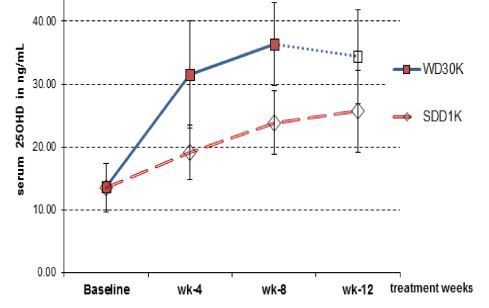Vitamin D – 91 percent safely got above 30 ng in 2 months with weekly 30,000 IU
Safety and Efficacy of Weekly 30,000 IU Vitamin D Supplementation as a Slower Loading Dose Administration Compared to a Daily Maintenance Schedule in Deficient Patients: A Randomized, Controlled Clinical Trial
J Pharmacovigil 2017, 5:4 DOI: 10.4172/2329-6887.1000233
Bela E Toth1*, Istvan Takacs2, Laszlo Szekeres3, Boglarka Szabo2, Bence Bakos2 and Peter Lakatos2
1 University of Debrecen, Faculty of Pharmacy, Department of Pharmaceutical Surveillance and Economy, Debrecen, Hungary
2 Semmelweis University, Faculty of Medicine, 1st Department of Internal Medicine, Budapest, Hungary 3National Institute of Rheumatology and Physiotherapy, Budapest, Hungary
Corresponding author: Bela E Toth, Department of Pharmaceutical Surveillance and Economy, University of Debrecen, Faculty of Pharmacy, Nagyerdei Krt. 98, Debrecen, 4032 Hungary, Tel: (36) 209429916; E-mail: tothe.bela@pharm.unideb.hu
📄 Download the PDF from VitaminDWiki
30,000 IU weekly for 8 weeks
Dashed line = 1,000 IU daily

Introduction: The primary objective of the study was to assess the safety and the efficacy of a “Slower Loading” dose of 30,000 IU vitamin D3 supplementation administered in a weekly schedule for 12 weeks in vitamin D deficient patients compared to the daily equivalent dose of 1000 IU/day regimens in a clinical trial.
Methods: This open label, randomized, controlled, multicenter clinical trial was performed during the spring and summer period enrolling adult subjects with 25OHD levels <20 ng/ml. In a sub-study presented here, subjects were randomized into two treatment groups using 30,0000 IU Vitamin D3 film coated tablets either in weekly (WD30K group, daily dose equivalent of 4286 IU/day) or a standard dose for maintenance treatment in a daily administration (SDD1K group, 1000 IU/day). Subjects in a control group received a similar 30,0000 IU Vitamin D3 film coated tablets in a once-per-month schedule (MD30K), dosing schedule for 12 weeks, (an equivalent to 1000 IU/day). The assessment of efficacy made by the changes in 25OHD and PTH levels in a throughout 12 weeks. Routine laboratory tests, serum and urinary calcium served for laboratory-safety assessments in every 4 weeks throughout the duration of the study.
Results: The baseline values of 25OHD at in group (WD30K, SDD1K and MD30K) were in similar range: 13.7 ± 3.7 ng/mL, 13.48 ± 3.9 ng/mL and 13.1 ± 4.3 ng/mL, respectively. A daily dose of 1000 IU for 12 weeks was effective in restoration of 25OHD values to above 20 ng/mL (50 nmol/L), however the median of the group failed to attain the 30 ng/mL (75 nmol/L) threshold. Dose-response was statistically different in the 4286 IU/day group compared to a 1000 IU/daily dose (p<0.001) for all study visits. Treatment efficiency assessed on two levels and for treatment duration of 8 and 12 weeks. The limit of 25 ng/mL was achieved by 95% of patients in 8 weeks with 30,000 IU/wk administration (vs. only 33% with 1000 IU/d) but more prominent difference observed with the limit of desired range (>30 ng/ml): 91% vs. 10% of subjects in after 8 weeks with 30,000 IU/wk and 1000 IU/d doses and 95% vs. 24% by end of the 12 weeks of treatment. The treatment-related increment potential was in a range of 2.26-2.92 ng/week for the weekly 30K dosing group compared to 1.32-1.70 ng/week for the 1000 IU/day standard maintenance dose group after 8 weeks. Treatment with 30,000 IU doses of Vitamin D3 in a weekly administration for 12 weeks did not abolish serum calcium levels. No difference in frequency of laboratory adverse events and other safety parameters was observed compared to lower maintenance doses or to control group.
Conclusion: The safety of weekly loading oral doses of 30,000 IU vitamin D3 tablets was demonstrated and efficacy compared to the maintenance treatment with a daily dose equivalent of 1000 IU/d, in a daily or in monthly schedule in vitamin D deficient, adult population. Weekly administration of 30,000 IU loading dose for 12 weeks does not raise safety concern, but provides an effective tool for normalization of 25OHD levels to the desirable level of >30ng/mL in deficient patients.
From the PDF
“ Overall we did not find any difference in adverse event frequency among daily, weekly and monthly treatment schedule applied in this sub-study”
“ Daily maintenance dosing of vitamin D3 in clinical practice often fails to achieve optimal outcomes,”
“ On the other hand the biological half-life and the pharmacology of vitamin D indicate that it is suitable also for weekly or monthly dosing”
“ The potential safety concerns that a high intermittent weekly dosing of cholecalciferol might cause transient effects (i.e. hypercalcemia) because of the production of 1,25-dihydroxyvitamin D, have been ruled out in a clinical report”
